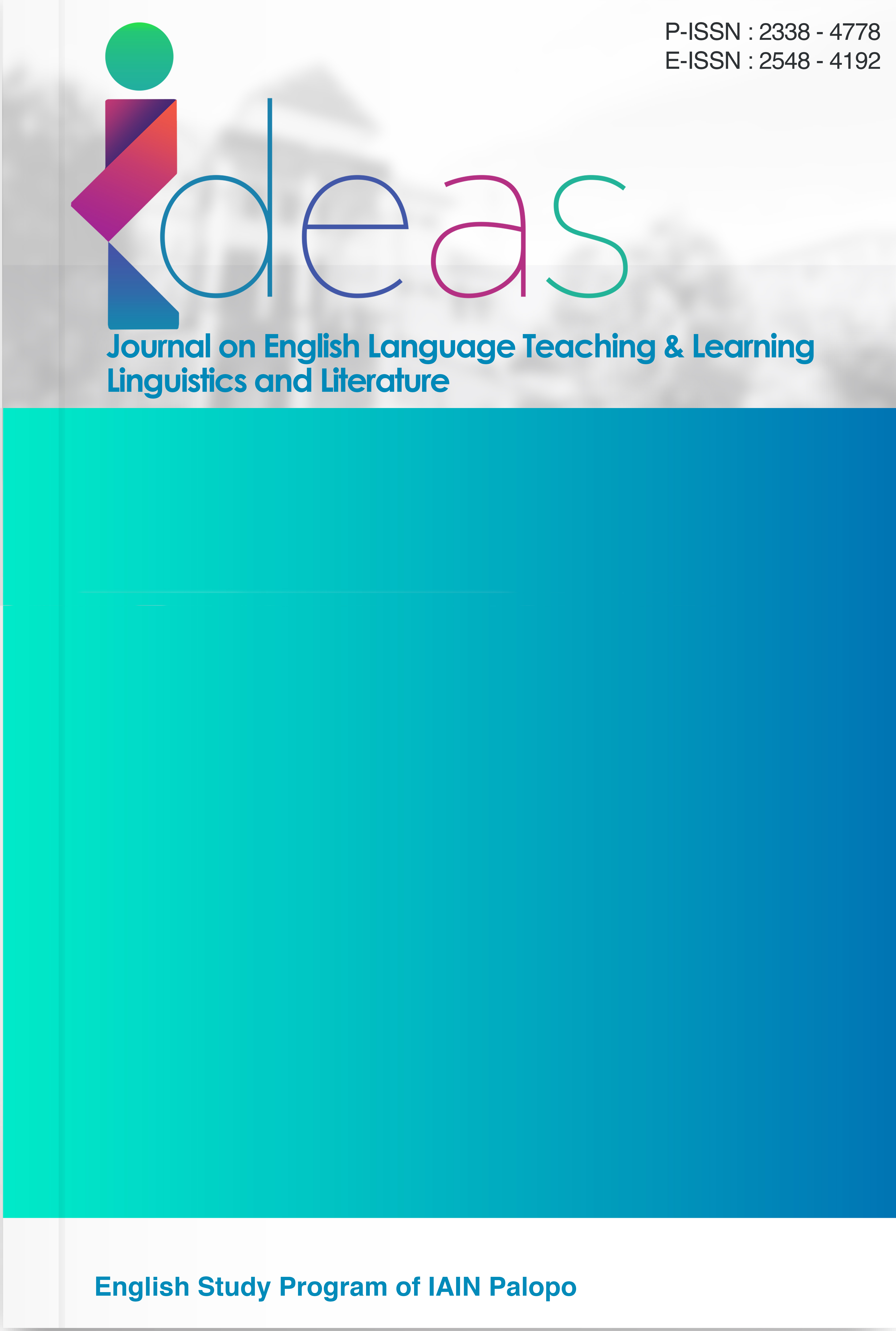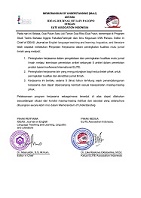EFL Undergraduate Students' Perceptions of Slick Write as Web-Based Writing Support Tools: A Qualitative Case Study
DOI:
https://doi.org/10.24256/ideas.v13i2.7374Keywords:
Automated writing evaluation, EFL writing, Perceptions, Slick Write, Web-based writing toolsAbstract
The integration of web-based writing support tools in EFL writing instruction has gained attention due to their potential to address students' writing challenges. This study investigates EFL undergraduate students' perceptions of Slick Write as a web-based writing support tool in academic contexts. The study employed a qualitative case study approach. At the same time, the data were collected from ten eighth-semester undergraduate students at the State Islamic University of North Sumatra through closed-ended questionnaires and semi-structured interviews. All participants had prior experience using Slick Write for at least one semester in their academic writing tasks. Data from questionnaires and interviews were analyzed using Braun and Clarke's six-step thematic analysis framework. The findings revealed five main themes: effectiveness in detecting grammar errors, clarity and quality of feedback, increased writing autonomy and confidence, enhanced structured revision practices, and suitability with academic writing conventions. A significant concern identified was potential over-reliance on automated tools. While findings highlight Slick Write's benefits in supporting academic writing development, they also suggest the need for balanced implementation to prevent dependency. This study contributes to computer-assisted language learning literature by examining a less-explored tool through sociocultural and automated writing evaluation theoretical lenses, providing insights into technology-mediated writing instruction in Indonesian Islamic higher education contexts. Future research should explore the long-term impact of web-based writing tools on writing development and investigate their effectiveness across different academic disciplines
References
Anshari, M., Almunawar, M. N., Shahrill, M., Wicaksono, D. K., & Huda, M. (2017). Smartphones usage in the classrooms: Learning aid or interference? Education and Information Technologies, 22(6), 3063–3079. https://doi.org/10.1007/s10639-017-9572-7
Astuti, E. P. (2021). Indonesian EFL students’ challenges in writing academic essays: A case study in a state university. . . Journal of English Education and Teaching, 5(3), 364–380.
Braun, V., & Clarke, V. (2006). Using thematic analysis in psychology. Qualitative Research in Psychology, 3(2), 77–101. https://doi.org/10.1191/1478088706qp063oa
Cohen, L., Manion, L., & Morrison, K. (2017). Research Methods in Education. Routledge. https://doi.org/10.4324/9781315456539
Creswell, J. W. (2013). Qualitative inquiry & research design. design _ Choosing among five approaches. (1).
Dewi, U. (2023). Grammarly as Automated Writing Evaluation: Its Effectiveness from EFL Students’ Perceptions. Lingua Cultura, 16(2), 155–161. https://doi.org/10.21512/lc.v16i2.8315
Fan, N. (2023). Exploring the Effects of Automated Written Corrective Feedback on EFL Students’ Writing Quality: A Mixed-Methods Study. SAGE Open, 13(2). https://doi.org/10.1177/21582440231181296
Fithriani, R. (2021). Integrating Wiki in Hybrid EFL Writing Class: Exploring Indonesian Students’ Perceptions of Its Benefits and Challenges. Journal of Community Research and Service, 5(1), 27–41.
Fitri, A. R., & Dewi, U. (2024). UNDERGRADUATE STUDENTS’ PREFERENCE AND PERCEPTIONS ON THE USE OF QUILLBOT AND GRAMMARLY AS PARAPHASING TOOLS. Indonesian EFL Journal, 10(2), 167–174. https://doi.org/10.25134/ieflj.v10i2.9868
Flick, U. (2014). The SAGE Handbook of Qualitative Data Analysis. SAGE Publications, Inc. https://doi.org/10.4135/9781446282243
Godwin-Jones, R. (2018). Second language writing online: An update. Language Learning & Technology, 22(1), 1.
Hyland, K. (2019). Feedback in Second Language Writing (K. Hyland & F. Hyland, Eds.). Cambridge University Press. https://doi.org/10.1017/9781108635547
Lantolf, J. P., & Thorne, S. L. (2006). Sociocultural theory and the genesis of second language development. Oxford University Press.
Li, J., Link, S., & Hegelheimer, V. (2015). Rethinking the role of automated writing evaluation (AWE) feedback in ESL writing instruction. Journal of Second Language Writing, 27, 1–18. https://doi.org/10.1016/j.jslw.2014.10.004
Lin, T., Chen, J., Li, M., & Manalo, E. (2022). Beyond error correction: Student engagement with automated writing evaluation tools. Computer Assisted Language Learning, 35(6), 1244–1271.
Meriam, sharan, & Tisdell, E. (2016). merriam. Jossey-Bass.
Patton, M. Q. (2015). Qualitative research & Evaluation Methods (4th ed.). SAGE Publications, Inc.
Rahimi, M., Fathi, J., & Zou, D. (2024). Exploring the impact of automated written corrective feedback on the academic writing skills of EFL learners: An activity theory perspective. Education and Information Technologies. https://doi.org/10.1007/s10639-024-12896-5
Shi, H., & Aryadoust, V. (2024). A systematic review of AI-based automated written feedback research. ReCALL. https://doi.org/10.1017/S0958344023000265
Swales, J. M. (2019). The futures of EAP genre studies: A personal viewpoint. Journal of English for Academic Purposes, 38, 75–82. https://doi.org/10.1016/j.jeap.2019.01.003
Vygotsky, L. S. (1978). Mind in Society: The development of higher psychological processes (M. Cole & V.-J. Steiner, Eds.). Harvard University Press.
Wang, Y., Luo, X., Liu, C. C., Tu, Y. F., & Wang, N. (2022). An Integrated Automatic Writing Evaluation and SVVR Approach to Improve Students’ EFL Writing Performance. Sustainability (Switzerland), 14(18). https://doi.org/10.3390/su141811586
Warschauer, M., & Grimes, D. (2008). Automated Writing Assessment in the Classroom. Pedagogies: An International Journal, 3(1), 22–36. https://doi.org/10.1080/15544800701771580
Xie, Y., Chen, Y., & Ryder, L. H. (2021). Effects of using mobile-based virtual reality on Chinese L2 students’ oral proficiency. Computer Assisted Language Learning, 34(3), 225–245. https://doi.org/10.1080/09588221.2019.1604551
Zhang, S. (2021). Review of automated writing evaluation systems. Journal of China Computer-Assisted Language Learning, 1(1), 170–176. https://doi.org/10.1515/jccall-2021-2007
Downloads
Published
Issue
Section
Citation Check
License
Copyright (c) 2025 Anis Syafa Wani, Utami Dewi

This work is licensed under a Creative Commons Attribution-ShareAlike 4.0 International License.
Authors retain copyright and grant the journal right of first publication with the work simultaneously licensed under an Attribution-ShareAlike 4.0 International (CC BY-SA 4.0) that allows others to share the work with an acknowledgement of the work's authorship and initial publication in this journal.
Authors are able to enter into separate, additional contractual arrangements for the non-exclusive distribution of the journal's published version of the work (e.g., post it to an institutional repository or publish it in a book), with an acknowledgement of its initial publication in this journal.
Authors are permitted and encouraged to post their work online (e.g., in institutional repositories or on their website) prior to and during the submission process, as it can lead to productive exchanges, as well as earlier and greater citation of published work (See the Effect of Open Access)




